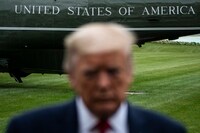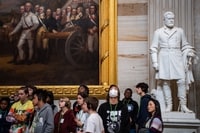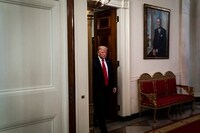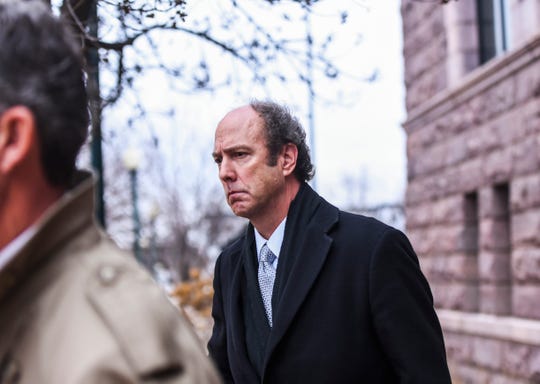The government’s halting response to the coronavirus pandemic represents the culmination of chronic structural weaknesses, years of underinvestment and political rhetoric that has undermined the public trust — conditions compounded by President Trump’s open hostility to a federal bureaucracy that has been called upon to manage the crisis.
Federal government leaders, beginning with the president, appeared caught unaware by the swiftness with which the coronavirus was spreading through the country — though this was not the first time that an administration seemed ill-prepared for an unexpected shock. But even after the machinery of government clanked into motion, missteps, endemic obstacles and lack of clear communication have plagued the efforts to meet the needs of the nation.
Political Reckoning
“A fundamental role of government is the safety and security of its people,” said Janet Napolitano, the former secretary of homeland security. “To me that means you have to maintain a certain base level so that, when an event like a pandemic manifests itself, you can quickly activate what you have and you have already in place a system and plan for what the federal government is going to do and what the states are going to do.”
That has not been the case this spring. The nation is reaping the effects of decades of denigration of government and also from a steady squeeze on the resources needed to shore up the domestic parts of the executive branch.
This hollowing out has been going on for years as a gridlocked Congress preferred continuing resolutions and budgetary caps to hardheaded decisions about vulnerable governmental infrastructure and leaders did little to address structural weaknesses.
The problems have grown worse in the past three years. Trump was elected having never served in government or the military. That was one reason he appealed to many of those who backed him. He came to Washington deeply suspicious of what he branded the “deep state.” Promising to drain the swamp, he has vilified career civil servants and the institutions of government now called upon to perform at the highest levels.
His transition was messy and since then his administration has been slow to populate the thousands of political slots atop federal agencies, and the president has seemed to prefer acting agency heads to those who can win confirmation from the Senate and the authority that imprimatur conveys. He has targeted career officials and sought retribution for those who differed with him, particularly those whose job it is to find and expose problems.
“One thing to keep in mind is that government takes on hard problems,” said David E. Lewis, a political science professor at Vanderbilt University. “They’re often problems that can’t be solved by the market and there aren’t private entities to solve them.”
He added: “We’re seeing a government that is suffering now from a long period of neglect that began well before this administration. And that neglect has accelerated during this administration.”
The question is whether the weaknesses and vulnerabilities exposed by the current crisis will generate a newfound interest among the nation’s elected officials — and the public — in repairing the infrastructure of government and a sense of urgency on the part of the public to encourage them to do so. Or will partisanship and public indifference lead to a continuation of the status quo?

A critical look at government
Public trust in government has declined sharply for the past half century. In the early 1960s, more than 7 in 10 Americans said they trusted government to do the right thing all or most of the time. A year ago, a Pew Research survey found that just 17 percent of Americans expressed that view.
Attitudes began to turn more negative during Vietnam and Watergate. Over the next decades, there were occasional increases in public trust, but the trendline continued downward. There was also a spike upward after the terrorist attacks on Sept. 11, 2001. Since then, there has been a steady decline amid deepening political divisions and intensifying anti-government rhetoric.
Over these years, there have been a series of major government breakdowns that helped shake confidence in government’s competence. Some are relatively recent: the 2003 invasion of Iraq; the response to Hurricane Katrina in 2005; the Deepwater Horizon oil well blowout in the Gulf of Mexico in 2010; the crashing website for the Affordable Care Act in 2013.
Other breakdowns happened longer ago or are less remembered but nonetheless highlight ongoing weaknesses, whether the explosion of the Challenger space shuttle in 1986 or a flu vaccine that sickened many recipients in 1976.
[Where states are reopening after the pandemic]
The pandemic has forced another critical look at government’s competence. For months, the Trump administration has been running behind to bring testing capacity to the levels needed. That was true as the virus was taking hold and when more tests might have helped contain the spread. It is the case now as businesses look to reopen but cannot assure safety for workers or their communities without the widespread availability of tests, which so far does not exist.
Stockpiles of needed equipment were never adequate for the scale of the pandemic either, and the government was slow to ramp up production. The government’s economic intervention, while massive in dollars and well-meaning in intent, also has run into problems.
In contrast to many European nations, where the strategy has been to keep payrolls afloat, the U.S. program has relied on direct payments to individuals, unemployment insurance for furloughed workers, loans to small businesses (in some cases forgivable) and aid to some major industries, such as airlines.
Speed took precedence over precision in the design of the program. Delays were common. Areas of the country hardest hit by the virus in March and early April were sometimes shortchanged as money flowed to areas less affected. Payments through the Small Business Administration ended up in the hands of big firms like Ruth’s Chris steakhouses or entities like the Los Angeles Lakers. Treasury Department officials had to move swiftly to get those payments returned.
Flaws in the nation’s unemployment insurance program, a patchwork system run through the states, highlighted inequities, as benefits vary from state to state, as do eligibility requirements and length of assistance.
Florida’s has drawn the most criticism. That state’s program was redesigned when now-Sen. Rick Scott (R) was governor to make it more difficult to qualify for assistance. Recently it has been plagued by computer problems. A recent headline on the Miami Herald website said, “Florida’s jobless benefits program finding new ways to confound, infuriate the unemployed.”

Congress authorized an additional $600-a-week payment through July for those unemployed, on top of what they would receive from their state program, which has resulted in some people receiving more money while being unemployed than when they were working.
Ricardo Reis, an economist at the London School of Economics, said that the U.S. program is one of the largest in the industrialized world but not necessarily the most efficient. “To get the same bang you’ve got to spend a lot more bucks because you’re sending a check to everyone, right?” he said “A lot of people don’t need a check.”
“Much of the response at the federal level has been predicated on the idea that we’re just going to take a holiday for a few months and then go back to where we were,” said a skeptical Steven J. Davis, a professor of international business and economics at the University of Chicago’s Booth School of Business.
Federal Reserve Chair Jerome H. Powell warned last week of “significant downside risks” to the future of the economy.”
The jury is still out as to whether what the government has done is either adequate or efficient. “My impression from the outside is that we have significantly mal-designed the economic assistance and adjustment system,” said Philip Zelikow, a professor at the University of Virginia who served in five administrations and was executive director of the 9/11 Commission.
“The counter to that is we just needed to get the trillions out the door,” he added. “Maybe after analysis, that argument could have merit [but] I suspect this still could have been done better under the time constraints.”
Meanwhile, lawmakers are now locked in age-old ideological battles at a time when fresh thinking will be needed to help workers who could face long periods of unemployment and businesses threatened by closure by a pandemic that appears certain to create a new normal whenever the economy does reopen.
“I think this event is revealing of what governance wonks have been warning about for a long time, namely that we haven’t been very focused on the basic governing systems we need to execute policy successfully,” said William Galston of the Brookings Institution. “The competency of government to serve as an instrument of policy delivery has been weakened substantially. One of our long-term tasks is to rebuild that capacity.”

Chronic weaknesses are well known
Gene Dodaro, the comptroller general, leads the Government Accountability Office, the agency that is tasked with being a watchdog for government performance. He sees structural weaknesses that constantly impede performance. “The hardest part of my job is getting people to focus on things before they become a crisis,” he said.
The GAO regularly produces a list of areas of high risk in government performance. The most recent, issued in 2019, began with this assessment: “The ratings for more than half of the 35 areas on the 2019 High Risk List remain largely unchanged. Since GAO’s last update in 2017, seven areas improved, three regressed, and two showed mixed progress.”
“Fundamentally we have a legacy government that hasn’t kept up with the world around it,” said Max Stier, president and chief executive of the Partnership for Public Service. “We create government and capacity around the problems of the day and there’s not much refreshed. . . . It does not lie with a single administration. It is endemic through modern times and not just the executive [branch] but in Congress.”
To take just one example, government has allowed its technology infrastructure to age in place. According to Dodaro, Washington spends about $90 billion a year on its IT systems — about three quarters of the money going to supporting operations and maintenance of existing systems, starving investment in new technology.
[Stories from the coronavirus pandemic: An oral history]
A call for technology upgrades is not a new problem. In 1995, Dodaro said he recommended that every agency create a position of chief information officer. Congress followed suit the next year, he said, but resistance in the agencies hampered the progress. In 2014, Congress enacted a second piece of legislation to spur what had been started nearly two decades earlier.
The Department of Defense and Veterans Affairs have been working to make medical records easily transferrable when personnel leave the military and become eligible for VA benefits. Billions have been spent but the problem hasn’t been solved.
Among those with the most antiquated computer systems are two agencies tasked with delivering economic assistance to workers this spring, the Small Business Administration and the Internal Revenue Service.
“SBA was asked to do the impossible on top of antiquated technologies,” said Paul Light, a professor of public service at New York University.
Some unemployment insurance systems run on mainframe computers that are 40 years old. In April, several states put out a call for people familiar with programming language for COBOL, introduced half a century ago, to help keep their systems running.
More than the computer systems are aging; so too is the workforce assigned to work on them. Stier estimates that there are five times as many federal employees over age 60 working on IT issues as there are employees under age 30. “The talent pool in government has to be refreshed,” he said.

Aging technology highlights the weaknesses of the government’s infrastructure, but that is only one of the obstacles that hinders more effective performance. Over the years, the federal government has created a complex system for the delivery of services.
Much of the work done by government is now carried out by nongovernmental employees — private contractors, consulting firms, nonprofits and others not technically on the federal payroll. Tina Nabatchi, a professor of public administration at Syracuse University’s Maxwell School, estimates that as much as 70 percent of the work of government is done by these outside entities. “We’ve taken out the middle levels of bureaucracies,” she said.
One reason is the desire of some leaders to run government like a business, though the two are not alike. Another is to mask the true scope of government. John DiIulio, a political science professor at the University of Pennsylvania, said that earlier in its existence, the Department of Homeland Security had more full-time-equivalent contractors than full-time-equivalent employees. “We want a lot from government,” he said. “We don’t want a lot of government.”
Donald F. Kettl, a professor at the Lyndon B. Johnson School of Public Affairs at the University of Texas, said most Americans, including many lawmakers, view government services through a vending machine model: Money goes in at the top, a lever is pulled and services come out at the bottom. Inside, however, is a complicated and often cumbersome contraption.
Kettl described the U.S. health care system as “much more complex than anywhere else in the world,” a labyrinth of government, private insurers, public and private hospitals, physicians, nurses and other health care workers, all involved in the delivery and billing of services. “The strategy of competence means managing these really complex partnerships,” he said.
Another area where the United States is unique is in the number of political appointees atop agencies in the executive branch. The system is supposed to allow a president to gain control of the bureaucracy but vacancies and constant turnover in those jobs mean that, when in their posts, officials are often afflicted with short-termitis — focusing on matters of the moment and ignoring underlying structural weaknesses that can become crippling problems in a crisis.
Leadership is a critical ingredient in the functioning of government. A president can set priorities and focus his administration on making systems work more efficiently. But there is one more reason the work of making government better rarely attracts the attention of senior government officials. It often requires becoming mired in mind-numbing detail. In other words, however important the work might be, it’s just plain boring.

Reform, reorganization or something else
The last serious attempt at government reform was more than 20 years ago, when then-president Bill Clinton asked his vice president, Al Gore, to head up what became known as the “reinventing government” initiative
Clinton believed that people needed to trust that their money was being spent wisely before they would trust the government itself. “If you convinced America you were being really, really careful about their tax dollars, then a lot of this animosity toward government would decrease,” said Elaine Kamarck of the Brookings Institution, who directed the project for several years.
The program may best be remembered for Gore’s appearance on “The Late Show with David Letterman,” where he donned protective glasses and broke a government-issued ashtray with a hammer to ridicule the cost and complexity of government procurement regulations.
The reinventing government initiative achieved some success and was aided by the fact that the timing coincided with a broader transition from the old industrial economy to the new information-age economy. “We could take advantage of a lot of the technology and that helped us cut,” Kamarck said.
Whatever progress was made is now long in the past. “Even if it had been wildly successful it would have been out of date four or five years after it was done,” Stier said.
Before that effort, the last president to address government reform in a serious way was Jimmy Carter. He created the Department of Energy and broke up what then was known as the Department of Health, Education and Welfare by creating a separate Department of Education.
Carter liked to look under the hood of government; few of his successors have had the same desire. “In terms of basic reorganization, you’ve got to go back to the 1950s and Herbert Hoover to find the last reorganization movement,” Light said, referring to a commission the former president headed after he left office.
Today, there is debate about whether government should or even can be reformed in those ways. The creation of DHS in the aftermath of 9/11 is a case in point. The hastily created department became a hash of many different entities pulled from across the government.
The departmental structure has made setting clear priorities far more difficult, as it serves multiple masters. “If you look at DHS, they have to report to more than 100 different congressional oversight committees,” said Mark Harvey, former senior director for resilience policy at the National Security Council.
Some students of government say a more pressing priority than fundamental reorganization should be finding ways to improve how agencies collaborate when confronted with the kind of crisis now facing the country. Today’s problems, they say, no longer fit without the boundaries of a legacy government structure.

The question of trust
Marc Hetherington, a professor at the University of North Carolina, said the public conversation about government began to shift with the election of Ronald Reagan in 1980. Before that, anti-government rhetoric focused more on what government ought and ought not to do, themes highlighted by Arizona Sen. Barry Goldwater (R) during his 1964 presidential campaign.
“What changed with Reagan and the decades since is that the conversation moves away from what government ought to do to government is incompetent to do things,” he said. “That’s a big change, with a fundamentally different message.”
Throughout the conservative movement since, that message has been a staple, with the often explicit goal of shrinking the federal government, cutting resources to starve the beast. “Sometimes poor performance is trying to do government on the cheap,” Lewis said. “There is a penny-wise, pound-foolish idea of how we manage government agencies.”
Hetherington said he has noticed one thing from his research about trust in government. Whenever the focus is on the military or national security, trust increases. When the focus shifts away to other programs, particularly those safety net programs such as welfare or food stamps, which serve disadvantaged populations, trust decreases.
But if Republicans have made this kind of rhetoric a staple of their message, Democratic politicians have engaged in some of the same kind of thing. “Every candidate has campaigned on a bureaucracy-bashing theme,” Nabatchi said. “That message has gotten through to affect people’s confidence in government.”
The president’s disdain is on display constantly, far more so than for past presidents. Hetherington said that in this area, Trump is “off the charts. Whereas a lot of Republican attacks on the government left certain things implicit, the Trump people have made them explicit.”
There is much that works well in the federal government, particularly everyday activities that citizens take for granted. Career civil servants on the whole are dedicated and skilled. But when the challenges shift from ordinary to extraordinary, cracks within the system are exposed, demands on leadership rise and the government’s competence is rightly called into question. This has been such a time.
It is an open question whether the more intense focus on the federal government will result in more calls to deal with the underlying weakness or whether criticism of the administration’s response — and the political divisions surrounding it — will further degrade people’s trust in the institutions they have turned to at this moment.
“We don’t want to invest in the capacity of government to get the job done,” Kettl said. “But we are happy to complain immediately when there’s sand in the gear that causes the system to seize up.”


